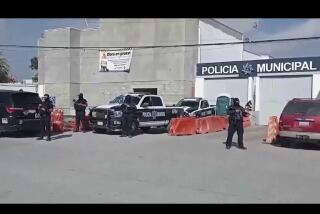Scotland Reforms Land Laws, to Gentry’s Dismay
A statue of the first Duke of Sutherland gazes out over the rugged Highlands, an enduring insult to Scottish nationalists who see him as a symbol of everything that went wrong with their country nearly two centuries ago.
Now, using the powers that it won when it got its own Parliament four years ago, Scotland has passed legislation that some hope will finally settle the score with the duke and other 19th-century aristocrats who drove thousands of tenants off their land in what became known as the Highland Clearances.
The legislation dramatically reforms the region’s land laws by entitling crofters -- small-scale tenant farmers -- to buy the land they rent.
The new law will probably change the way Scotland is farmed and hiked; crofters could end up owning the land’s lucrative salmon fishing, hunting and mineral rights, and everyone will be free to roam what until now was private land.
Scottish reformers say they are doing away with a feudal relic.
But to Peter de Savary, who owns the castle where Madonna was married two years ago, “this legislation borders on communism.”
Some big landowners have threatened to appeal to the European Court of Human Rights as a violation of their property rights. And they have the support of some of their tenants, who say they had no problem with the old system.
It’s not just about land. Ever since Scotland merged with England in 1707, Scots have nursed a grievance. Although they have risen in the British establishment to become prime ministers, generals and tycoons, many also believe that be it oil, sheep or grand living, the Scots do the hard work and outsiders reap the profits.
The Land Reform Bill is one of the most important steps taken by their legislature since Tony Blair’s government gave Scotland and Wales limited autonomy. Supporters say the new law will boost the economy, empower rural communities and the 30,000 crofting families, and rectify a situation in which half of Scotland’s private land is owned by just 343 people.
“Ownership of Scotland’s land is carved up less fairly than anywhere else in western Europe,” the Glasgow newspaper the Herald said in an editorial.
But de Savary argues that investors like him are just as important to the economy. De Savary transformed Skibo Castle in the Highlands from a private home into the Carnegie Club in 1995. It is now a resort where the rich can golf, ride horses, hike and dine lavishly.
“The Madonnas and Michael Douglases of the world won’t come here anymore. Security is important to these people,” de Savary said.
Another opponent is Mohamed Al Fayed, owner of Harrods department store and father of Dodi Al Fayed, who died with Princess Diana in a 1997 car crash. He owns the 65,000-acre Balnagown Estates, 10,000 acres of which is croft land.
“He bought this estate as a retreat in 1972 and has invested millions of pounds in it,” said his land manager, Gordon A. Robertson.
Keith Aitchison, who helped draft the legislation, said it wasn’t a matter of taking revenge on the landowners but of “trying to build a modern European society,” which involves “abolition of feudal holdings.”
Previously, crofters already had the right to buy the small plot of land under their homes, but only about one-fifth in the Highlands did so, seeing little financial advantage given the generally low rents. The new law enables them to buy grazing land too, as well as land shared by a number of crofters.
It stipulates that this land be valued by an independent assessor. Crofters who need money to buy the land can get a grant from a government fund of profits from Britain’s lottery.
The Highland Clearances began in the late 1700s, after the last Scottish rebellion against English rule, and continued for more than a century. Overpopulation, the potato famine and the collapse of the kelp industry made it easy for landlords to force or trick people out of their land.
Waves of Scots emigrated, and those who remained were pushed onto tiny plots and charged rent.
One of the prime movers in the clearances was George Cranville, the first Duke of Sutherland (1758-1833), who owned a Delaware-sized chunk of the Highlands.
Like many of the Highlands’ wealthiest landowners, he was English, not Scottish, and an absentee landlord. In total, he controlled more than a million acres of land in Britain, with tens of thousands of tenants. Some 700 families were evicted from his Scottish land in just three years.
The inscription on his towering statue says he was loved, revered and cherished by his tenants. But graffiti scrawled on the statue in Gaelic, the native language, says: “The Highlands for the Highlanders.”
Crofting can be a harsh life. The soil is often poor, and crofters have to supplement their earnings with part-time jobs. But some have mixed feelings about the legislation.
Virginia MacLean, 71, whose family pays $22.40 a year for a croft of about 50 acres on Balnagown Estates, said: “I don’t think the new law is necessary.” She said the landlords, whom she calls “the gentry,” bring a lot of business to the area.
Robert Matheson, 53, who pays $51 a year for 450 acres, said many crofters distrust landlords and some call them dictators.
Ian and Netta MacKenzie, former schoolteachers who pay $35 for a small croft in Elphin in the western Highlands, said many crofters are so poor, they need government help to buy the land.
Still, they said, the new law is “a great idea of empowerment for the common man.”
More to Read
Start your day right
Sign up for Essential California for news, features and recommendations from the L.A. Times and beyond in your inbox six days a week.
You may occasionally receive promotional content from the Los Angeles Times.






